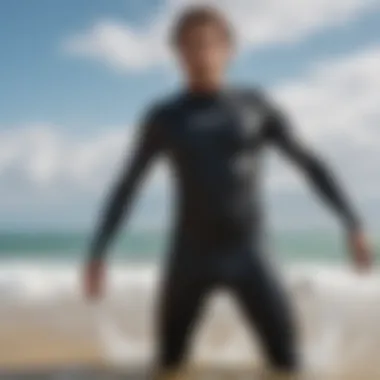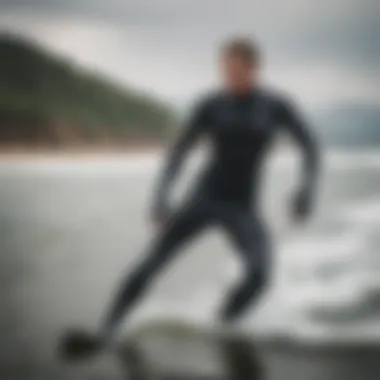Selecting the Perfect Wetsuit for Kiteboarding


Intro
Choosing the right wetsuit for kiteboarding can feel like a daunting task, especially for those new to the sport. The ocean or lake can be as unpredictable as a cat on a hot tin roof, and having the appropriate gear is crucial to ensure both comfort and performance. Understanding factors like materials, fit, thickness, and special features can arm kiteboarders with the knowledge they need to make informed decisions.
In this comprehensive guide, we will delve into each aspect affecting the choice of a wetsuit, breaking it down to the essentials that can enhance your experience on the water. Whether you're a weekend warrior or a seasoned pro, the insights shared here will help you find a wetsuit that meets your specific needs.
Gear Insights
Latest Gear Reviews
The wetsuit market has seen a significant evolution, with brands constantly rolling out innovative designs and materials that enhance performance. Key players like O'Neill, Rip Curl, and Mystic have been at the forefront, offering options that cater to various situations.
For instance, the O'Neill Hyperfreak series is known for its lightweight feel while still providing ample warmth, making it ideal for those chilly morning sessions. Meanwhile, Rip Curl's Flashbomb line is praised for its quick-drying capabilities, which is an essential feature for kiteboarders who may want to jump back in the water shortly after a session. Brand loyalty can play a part in decision-making, but it’s wise to keep an eye on independent user reviews and testing reports. This approach can shed light on practical performance beyond marketing hype.
Essential Gear for Beginners
If you're just getting your feet wet in the world of kiteboarding, knowing what to look for in a wetsuit will save you time and help you avoid common pitfalls. First, consider the thickness of the wetsuit depending on the water temperature where you'll be kiteboarding. In warmer waters, a thinner suit may suffice, like a 2mm or 3mm option, while in chillier climates, a 4mm or thicker suit may be advised.
Fit is also paramount. A wetsuit that fits like a glove—not too tight but snug—ensures that you stay warm without sacrificing mobility. Beginners should focus on the following:
- Flexibility: Look for suits made with elastane or similar materials that allow for easy movement.
- Zipper Style: Rear zippers can be easier for beginners, while front-zippers offer more flexibility, though they may take some getting used to.
- Seams: Blind-stitched seams provide better insulation, while flatlock seams are generally more affordable but can let in more water.
With the right wetsuit in hand, the next step involves honing your skills and safety practices, which we’ll explore next.
"The best time to learn kiteboarding? Always! But the right gear can make or break your experience."
Techniques and Tips
Whether you’re just starting or looking to sharpen your skills, understanding advanced techniques and safety practices is vital to ensure a seamless and enjoyable kiteboarding experience.
Understanding Wetsuits
Selecting the right wetsuit is more than just a matter of personal preference for kiteboarders; it’s about unlocking the full potential of the sport. Wetsuits serve a dual purpose—keeping you warm and offering a degree of protection from the elements, both crucial for an enjoyable experience on the water. Getting a grip on the nuances of wetsuits can save you from discomfort and even health hazards, especially when facing chilly waters or harsh conditions.
This section dives into what defines a wetsuit and the various types available, each catering to different needs and environments. Being aware of these factors allows riders to make informed decisions that align with their specific kiteboarding styles and local conditions.
Definition and Purpose
A wetsuit is essentially a snug-fitting garment made from neoprene, a type of synthetic rubber. Its primary function is to retain a thin layer of water next to the skin, which warms up thanks to the body heat. This insulating layer effectively protects against cold water in cooler temperatures.
Beyond warmth, wetsuits also offer other benefits such as:
- Protection from UV rays: While kiteboarding, you can be under the sun for extended periods, and a wetsuit acts as a barrier against harmful rays.
- Chafing protection: Water sports can lead to unpleasant chafing, and wetsuits help alleviate that discomfort, especially in sensitive areas.
- Impact resistance: Should you take a tumble, the wetsuit provides a bit of cushioning, reducing the risk of injury from board impact or sharp objects below the water’s surface.
Thus, understanding the core functions of a wetsuit sets the stage for choosing the right one.
Types of Wetsuits
Now that we know what a wetsuit is and its purpose, let’s explore the different types available. Each type serves specific conditions and rider preferences.
Full Suits
Full suits, as the name suggests, cover the entire body, providing maximum warmth and protection. These suits typically have long sleeves and full-length legs, making them excellent for colder waters. One key characteristic of full suits is their thickness, often ranging from 3mm to 5mm or more, depending on the temperature of the water.
The benefit of a full suite is its insulation; it keeps you cozy even during icy moments. However, they may feel restrictive for some, leading to mobility constraints. Hence, should you find yourself often kitesurfing in cool or cold climates, a full suit could be your best friend.
Shorty Suits
Shorty suits come as a happy medium. They feature short sleeves and short legs. This design is best suited for warmer waters, generally above 70°F. Their lightweight nature brings a handy combination of comfort and protection.
Because these suits expose more skin, they are easy to slip into and provide greater freedom of movement. One downside, however, is less overall warmth, which makes them less ideal for cooler conditions. If you love kiteboarding on sunny days, a shorty could well fit your needs.
Spring Suits


Spring suits present another variation, featuring long sleeves but short legs. Ideal for transitional seasons, they allow for reasonably warm conditions without overdoing it. Typically made from 2mm to 3mm thick neoprene, they provide enough coverage against the brisk wind while keeping you cooler than full suits.
They are a good compromise if the water is slightly chilly and you want to stay comfortable without overheating. Nevertheless, their design can result in some exposure to water on the legs, which may leave some parts feeling cold after extended periods.
Hybrid Suits
Hybrid suits mix elements of both shorty and full suits. The top is often a full-sleeve design, while the legs are short. This design offers the flexibility and ease of movement of a shorty, while still providing warmth for the upper body. Typically thicker and designed differently depending on the manufacturer, they are particularly popular among adventurous kiteboarders who often navigate varying climates and water conditions.
However, one must consider that these suits may lack the comprehensive coverage of a full suit, which could be a drawback for those who prioritize warmth. Depending on where and how frequently you kiteboard, a hybrid suit could provide the versatility you need while keeping comfort in mind.
Key Factors to Consider
When it comes to selecting the right wetsuit for kiteboarding, it's important to pay close attention to specific factors that will significantly influence your comfort and performance on the water. Each rider has unique needs based on their skill level, the type of water conditions they expect to face, and personal preferences. This section delves into these key factors, providing insights that can help steer you toward the perfect wetsuit tailored to your kiteboarding adventures.
Water Temperature
Cold Water Needs
In colder waters, several elements come into play when choosing a wetsuit. The primary focus is on the thickness of the suit. Typically, a wetsuit in the 4/3mm to 5/4mm range is ideal for chilly conditions, as it offers significant insulation and protects against hypothermia. The fact that cold water can sap your body heat faster than you can imagine makes this an essential consideration.
A notable feature in cold water wetsuits is the high neck design, which helps to keep water entry minimal and enhances warmth retention. While these suits can be less flexible than their warmer-water counterparts, they provide the necessary protection that justifies their bulk. Choosing a wetsuit that balances warmth and mobility will serve you well in the frigid waters where kiteboarding may not seem as inviting.
Warm Water Insights
On the flip side, warm water conditions typically call for a lighter approach when selecting a wetsuit. A thinner suit, or even a shorty, can work wonders here, as it ensures enough freedom of movement while providing sun protection and minor thermal management. A 2mm or 3mm wetsuit is generally adequate, giving you the breathability needed to stay comfortable and cool.
One unique aspect of warm water suits is the incorporation of quick-drying materials. These can help reduce the time spent in wet gear and allow you to get back on the water without the chilling effects of damp fabric clinging to your skin. However, it’s essential to remember that too thin a wetsuit might not provide enough insulation in the event of a sudden chill or fall into the water, so finding that balance is key.
Fit and Comfort
Size Chart Guidelines
Finding the perfect fit for your wetsuit starts with understanding size charts. Different brands may have slightly different sizing, which means that consulting the size chart can help you avoid ending up in a suit that is either too loose or too tight. A good fit would allow you to move comfortably without excessive water entering the suit.
The key characteristic of these guidelines boils down to accurate measurements. This means knowing your body’s specifics—height, weight, chest, waist, and hips can help you avoid the frustration of trying suits that just don’t work. A well-fitted wetsuit can significantly enhance your kiteboarding experience by maximizing flexibility and limiting water flow, both of which are essential while navigating those waves.
Importance of Stretch
Another critical aspect to consider is the stretchability of the wetsuit material. The more stretchable a wetsuit is, the easier it is to paddle and maneuver during kiteboarding. Many modern wetsuits are crafted with advanced materials that allow for greater freedom of movement.
This feature is especially relevant for activities that involve a lot of dynamic movement, like kiteboarding, where you want your suit to move with you rather than against you. The drawback, however, can sometimes be durability, as suits that prioritize stretch may be thinner and thus less resilient to wear and tear.
Material Selection
Neoprene Variants
Material choice is paramount, particularly when it comes to different types of neoprene used in wetsuits. Neoprene is the go-to material because it offers both insulation and flexibility. However, not all neoprene is created equal. You may come across variants like smooth skin neoprene that is fantastic for cold water but can be delicate, or closed-cell neoprene which is more robust but may not vent well.
The characteristic of exceptional thermal properties offered by neoprene makes it a popular choice among kiteboarders. Yet, understanding the specifics is vital; some neoprene can be quite stiff and thus impede movement, while others may feel like a second skin, which is often preferred.
Eco-friendly Options
As sustainability gains traction, many brands are now presenting eco-friendly options made from recycled and more environmentally conscious materials. These wetsuits often maintain performance levels while reducing your environmental footprint, appealing to those who are conscious about their purchase motivations.
While eco-friendly wetsuits still offer comparable warmth and stretch, the notable consideration is that they sometimes command a higher price due to the innovative materials used. Additionally, it can take some time to mold to your body as they tend to have a different break-in period compared to traditional neoprene. However, choosing a more sustainable product contributes positively to the environment and makes a statement about responsible consumption.
Understanding these key factors ensures that kiteboarders can choose wetsuits aligned with both their performance goals and personal values.
Features Enhancing Performance
Selecting the right wetsuit goes beyond just fit and materials; it’s about incorporating features that enhance your performance on the water. When you’re kiteboarding, every little detail counts. The right features can make your experience smoother, more comfortable, and even more enjoyable. Knowing what to look for ensures you’re not just equipped; you’re empowered. Here’s a look at some key features that contribute to a better kiteboarding experience.
Zipper Types


When considering how to get in and out of a wetsuit, the zipper type can make all the difference. There are two major formats you should know about: back zippers and chest zippers. Both have their own unique set of pros and cons.
Back Zippers
Back zippers are traditional and they’re still quite popular among many kiteboarders. This design allows for easy entry and exit, which is great when you’re in a hurry to hit the waves. The key characteristic is the convenience. You simply pull down the zipper and you’re in.
However, there are some things to consider. A back zipper can let in more water than other types. Although, many brands now focus on making these zippers more watertight. A unique feature of back zippers is their ability to accommodate a variety of suits, from shorties to full wetsuits. The main advantage is the ease of use.
"While back zippers are loved for their simplicity, always check how well they seal to keep the cold out."
Chest Zippers
Chest zippers bring a new twist, offering a different entry method. They’re typically favored for their reduced water entry compared to back zippers. The key characteristic of chest zippers is that they provide a snugger fit around the neck and torso, which means you won’t feel as much water trickle down your back.
The unique feature here is the design itself; it minimizes the chances of water seeping in. Some find chest zippers a bit trickier to use, especially if you’re new to this kind of wetsuit. The advantage is clear: a better seal often leads to a warmer experience when you’re in chilly waters.
Seams and Stitches
Seams play a critical role in how warm and durable your wetsuit is. The stitching method can affect everything, from flexibility to water resistance. Understanding the different seam types will help you make informed choices.
Flatlock Seams
Flatlock seams are one of the most common types you'll come across. They are stitched together in a way that allows for more stretch and flexibility, which is particularly important when you’re bending and stretching during kiteboarding. The key characteristic is their durability and comfort. You’ll often find these in entry-level suits.
While they are great for warm waters, they allow some water entry. This can lead your suit to get heavier over time, which might not be ideal for some conditions. The main advantage is that they are generally cheaper to produce, making them widely available.
Glued and Blindstitched Seams
If you’re looking for a suit that offers superior insulation, glued and blindstitched seams are worth considering. These seams have added layers to prevent water from seeping in. The key characteristic is the way they are constructed; they’re designed to keep cold water out while remaining flexible.
This unique feature makes them popular among more serious kiteboarders. Though they can be pricier, the thermal efficiency they offer, particularly in colder waters, often justifies the investment. The main downside is that not all brands may have the same quality of adhesion, so it’s wise to research.
Thermal Linings
Thermal linings can drastically affect how warm you feel while kiteboarding. With varying thickness and materials available, understanding insulation properties will enhance your performance.
Insulation Properties
The insulation properties of your wetsuit can dictate your comfort level during long sessions in cooler water. The key characteristic of a good thermal lining is its ability to trap body heat without being overly bulky. Finding a wetsuit that balances warmth and flexibility is key to the ultimate performance.
A unique feature here is the advancement in materials like titanium-infused neoprene that reflects body heat. This can significantly improve your experience if you frequently find yourself in chillier conditions. However, heavier insulation often means less mobility, which is something to consider.
Drying Time Considerations
When it comes to the drying time, you might not think it's that critical until you find yourself waiting for your suit to dry before taking the next plunge. The key characteristic of wetsuits with fast-drying materials is their ability to minimize water retention, thus speeding up the drying process.
The unique feature of these materials is that they can have micro-porous structures, which do not hold water like traditional neoprene does. This means less time spent waiting for your gear, allowing you to maximize your water time. On the flip side, you may want to ensure the suit remains effective in thermal insulation, as some faster-drying materials may not offer the same properties as thicker alternatives.
In summary, knowing these features can significantly elevate your kiteboarding experience. Make sure to carefully evaluate each aspect before committing to a suit; it's your armor against the elements, after all!
Personal Preferences and Needs
When it comes to choosing a wetsuit for kiteboarding, personal preferences and individual needs play a vital role. It’s not just about performance; it's also about feeling good while zipping through the waves. Everyone has unique tastes, which can greatly influence what feels right in terms of style, comfort, and functionality. Knowing what you want can save you from hours of shopping and ensure you choose the perfect wetsuit for your adventures.
Style and Aesthetics
The look of a wetsuit might seem trivial, but for many, it's a significant factor. Style can reflect a rider's personality or even help foster a sense of belonging within the kiteboarding community. Some riders prefer bold colors and patterns that stand out, while others may lean towards sleek, understated designs.
For instance, if you often kiteboard in areas where the water is bright and lively, a vibrant pattern could complement your surroundings beautifully. On the other hand, if you enjoy a more minimalist approach, selecting a solid color can give you a sophisticated edge. In addition to aesthetics, consider how easy it is to put the wetsuit on and take it off, as this can be affected by the color and style you choose.
Budget Considerations
When selecting a wetsuit, budget plays a huge role in the decision-making process. Finding a balance between quality and cost is crucial to ensure you get a wetsuit that meets your needs without breaking the bank.


Quality vs. Cost
This aspect is about weighing the benefits of high-quality materials against the price tag. A more expensive wetsuit can often offer superior insulation, flexibility, and durability. For example, if you spend a lot of time in cooler waters, springing for a high-quality suit could mean keeping warmer and more comfortable for longer.
The disadvantage here could be the upfront cost, which may push some towards cheaper, less effective options. However, investing in a quality wetsuit often leads to better performance in the water and reduces the need for frequent replacements, ultimately saving money over time.
Long-term Investment
Another key element to consider is viewing your wetsuit purchase as a long-term investment. Quality suits often come with guarantees and last through several seasons. The discussion of durability highlights the essence of this aspect.
Sure, a cheaper wetsuit might look appealing, but consider the wear and tear that comes with it after a few seasons. A well-made wetsuit retains its shape and functionality longer, allowing you to enjoy kiteboarding without worrying about your gear. The initial higher cost might sting, yet you could very well find yourself saving in the long haul.
In summary, understanding your personal preferences and needs when selecting a wetsuit can lead to a more enjoyable kiteboarding experience. Style matters, but so does an intelligent balance between quality and cost, ensuring that you’re equipped for your adventures without any hassle.
Purchasing and Maintenance
Choosing the right wetsuit extends beyond just picking the right model; it’s about making a well-informed purchase and ensuring that investment lasts. This section dives into two pivotal elements: where to shop and how to care for your wetsuit, each offering different advantages and considerations that could optimize your kiteboarding experience.
Where to Buy
Local Retailers
Shopping at local retailers can often feel like a treasure hunt. These shops are usually run by people who are passionate about watersports, and they can offer direct insights and recommendations. You get to physically try on wetsuits, which is a distinct advantage when it comes to finding that ideal fit. Flexibility, stretch, and comfort are almost impossible to gauge online.
Local retailers also create a sense of community. They may offer demos where you can test gear under real conditions or host kiteboarding workshops. However, a downside can be the limited selection, especially if you're looking for a specialty suit. Pricing might also not be as competitive as you'd find online. Despite that, the personalized customer service often outweighs these disadvantages, making local stores a worthwhile visit.
Online Stores
Turning to online stores can feel like unveiling a treasure trove of options. The variety is staggering; you can easily peruse through countless brands and styles without being limited by geography. Additionally, you're likely to find better deals and discounts than in brick-and-mortar establishments. Many online stores allow you to filter specific features, like thickness or material, making it easier to find exactly what you need.
However, there are notable pitfalls. You can’t try the wetsuit before you buy. This sometimes leads to sizing mishaps; returns can be a hassle. Moreover, shipping times can vary. Waiting for that perfect wetsuit to arrive may feel like watching paint dry. Choosing an online retailer with a generous return policy can mitigate some of these concerns, ensuring you get the right fit.
Wetsuit Care Tips
Proper care for your wetsuit significantly enhances its lifespan and functionality. Here’s how to keep it in top shape, maximizing your investment in kiteboarding gear.
Cleaning Procedures
Keeping your wetsuit clean might sound trivial, but it's crucial for maintaining its integrity. After each use, it’s best to rinse it with fresh water. Salt, sand, and sunscreen can quickly break down the neoprene, leading to less flexibility over time. A gentle scrub with a specific wetsuit cleaner is also recommended every so often to remove deeper stains or odors.
Key point? Don’t throw it in the washing machine. Harsh detergents and agitation can warp the material and ruin the seams. Instead, hand wash it in a tub or sink with cool water, treating it delicately. Once clean, hang it on a wide hanger to dry, ensuring it maintains its shape.
Storage Recommendations
When it comes to storing your wetsuit, placement is everything. Avoid cramming it into a tiny space or leaving it in direct sunlight to prevent fading and material degradation. Ideally, the wetsuit should be stored laying flat or hanging, but with the caveat of using a hanger that doesn’t put stress on thin areas like the shoulders.
A dedicated wetsuit bag can be an excellent option, providing protection from dust and potential rips. This storage approach significantly prolongs the use of your wetsuit and saves you from unnecessary expenses during the peak kiteboarding season.
"An ounce of prevention is worth a pound of cure." Taking the time for proper purchasing and maintenance doesn’t just save you money—it enhances your overall kiteboarding enjoyment.
Final Thoughts
Selecting the right wetsuit for kiteboarding is more than just a practical necessity; it can significantly enhance your overall experience on the water. This final section wraps up the essential insights and considerations that a kiteboarder needs to keep in mind. After exploring the previous sections on types of wetsuits, factors to consider, features that enhance performance, personal preferences, and how to care for your wetsuit, it all boils down to making choices that align with your specific needs.
Making an Informed Decision
When it comes time to decide on a wetsuit, being informed is vital. You've got to weigh your options carefully and consider various elements such as water temperature, fit, and materials. Keeping in mind that each person's body is unique, you should try on different styles and sizes to find what feels best for you. Pay attention to how the wetsuit moves with you and make sure it doesn't feel too tight or too loose, which can affect both performance and comfort.
Here are some things to keep in mind:
- Testing for Fit: Try moving around in the wetsuit as if you were kiteboarding. Bend your elbows and knees, and take a few steps.
- Seasonal Needs: If you plan to ride throughout the year, consider having more than one wetsuit for different seasons. This approach can save your skin from extreme temperatures.
- Research Brands: Knowing which brands have a good reputation for quality is beneficial. Online reviews and forums can guide you to the best options available.
"A good wetsuit is like a second skin. It protects you while allowing you to do what you love most at your best."
Wetsuit Contribution to Kiteboarding Enjoyment
The right wetsuit does more than just keep you warm; it can elevate your kiteboarding experience in several ways. With the proper gear, you can focus on the thrill of the ride rather than the discomfort of cold water or chafing seams.
- Enhanced Performance: A well-fitted wetsuit promotes better hydrodynamics, meaning you'll glide through water more efficiently. This increased performance allows you to unlock your full potential.
- Safety First: Depending on where you ride, colder water can pose risks like hypothermia. A good wetsuit acts as a barrier, protecting you against the elements.
- Longer Sessions: The more comfortable you are, the longer you can stay out on the water. A top-notch wetsuit can transform a chilly, short session into a joyful day full of kiteboarding, allowing for exploration and improvement in skills.















